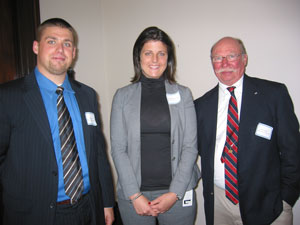 |
UNMC’s James Turpen, Ph.D., right, with Joe Britton, legislative assistant to U.S. Sen. Ben Nelson, and Martha Petkovich, legislative assistant to U.S. Sen. Chuck Hagel. Dr. Turpen addressed Britton, Petkovich and other senate staffers about the National Center for Research Resources IDeA program during a recent panel discussion in Washington. |
Dr. Turpen spoke with the senate staffers June 4 during a panel discussion in Washington organized by the EPSCoR/IDeA Coalition and the UNMC Office of Government Relations with the assistance of U.S. Sen. Ben Nelson’s office.
With more than half of current NIH funding going to just five states (Massachusetts, New York, Pennsylvania, California and Maryland), IDeA programs in Puerto Rico and 23 states, including Nebraska, are meant to make participating institutions more competitive for federal funding.
But IDeA has taken hits in recent years. Since peaking at a funding level of $222 million in fiscal year 2005, IDeA funding dropped to $220 million in 2006 and $218 million in 2007. The president’s fiscal year 2008 budget proposes an additional $5 million cut to the program’s funding.
“The insufficient funding that has developed over the past few years is having a negative impact on our ability to provide support at current levels,” Dr. Turpen said. “Due to current cuts, we have experienced a drop in the number of graduate students we can support and we have seen a drop in the support we can provide staff in the core facilities.”
More cuts in IDeA funding could be disastrous for the institutions involved, Dr. Turpen said.
The Senate Appropriations Subcommittee on Labor, Health and Human Services and Education, which has jurisdiction over funding for the IDeA program, met Tuesday to determine the proposed appropriation for IDeA. The full appropriations committee, of which Nelson is a member, meets Thursday to vote on their proposal. From there, the appropriations bill will go to the Senate floor, undergo conference negotiations with the House of Representatives and then be sent to the president for his signature or veto.
Joining Dr. Turpen on the panel on June 4 were:
- Patricia Hand, Ph.D., administrative director of the Mount Desert Island Biological Laboratory in Salisbury Cove, Maine;
- K. Gus Kousoulas, Ph.D., professor of virology and biotechnology at Louisiana State University;
- Frances Carr, Ph.D., professor of pharmacology and vice president for research and graduate studies at the University of Vermont; and
- Malcolm D’Souza, Ph.D., professor of chemistry at Delaware’s Wesley College.
All the panelists are involved in programs funded by IDeA.
The IDeA program has two main components — IDeA Networks of Biomedical Research Excellence (INBRE) and Centers of Biomedical Research Excellence (COBRE).
The INBRE program is meant to enhance research capacities of the IDeA states and increase the number of students pursuing careers in biomedical research. COBRE is meant to strengthen an institution’s research capabilities by improving the research abilities of the faculty through support of a multidisciplinary center, led by a peer-reviewed, NIH-funded investigator with expertise central to the theme of the grant proposal.
Each IDeA state is eligible for one INBRE. Dr. Turpen leads Nebraska’s INBRE — the Nebraska Research Network in Functional Genomics. The Nebraska INBRE is a 13-member network consisting of community colleges, undergraduate institutions and advance research institutions in Nebraska. It is funded through 2009 at a level of $16.9 million — the largest federally-funded research initiative at UNMC.
“The strength of the INBRE is support for both the physical and human infrastructure on the UNMC campus,” Dr. Turpen said. “Seven Biomedical Research Infrastructure Network (BRIN) Scholars are currently enrolled in graduate programs on this campus. These students are supported by INBRE during their first year in the program.”
The INBRE funding also helps support core research facilities by paying for large equipment purchases and salaries for facility staff.
Nebraska has four COBREs, two of which were awarded to investigators at UNMC. These are the Center for the Molecular Biology of Neurosensory Systems led by Shelley Smith, Ph.D., and the Nebraska Center for Cellular Signaling, led by Margaret Wheelock, Ph.D. Dr. Smith’s grant is funded at $10.6 million and Dr. Wheelock’s grant receives $9.9 million.
The UNMC total for IDeA grants is $36.4 million over five years, which amounts to $7.3 million per year and makes up 15 percent of the medical center’s NIH funding.
UNMC’s Office of Government Relations is working closely with Nebraska’s congressional delegation to explain the importance of the IDeA program to Nebraska in hopes that they will advocate for an appropriation of $250 million to the program for fiscal year 2008. Staffers for Nelson and U.S. Sen. Chuck Hagel, R-Neb., participated in the briefing.
Joe Britton, legislative aide to Nelson, said the senator is very supportive of the IDeA program.
“Small states like Nebraska are often at a disadvantage when it comes to research funding,” Britton said. “This is a program that helps level that playing field by enabling us to build up our research infrastructure while educating and encouraging the next generation of scientists and teachers. Nebraska will reap rewards for years to come because of this program.”
(UNMC Director of Government Relations Renee Fry, J.D., contributed to this report)